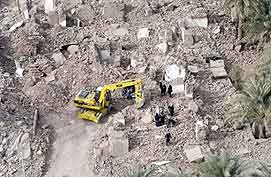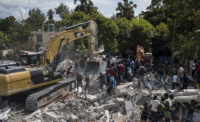 |
| Backhoe operator sifts through rubble in Bam, Iran. An earthquake lon Dec. 26 leveled thousands of unreinforced masonry buildings and killed more than 20,000. |
Traditional materials used in most buildings destroyed by the late-night Dec. 26 Iranian earthquake contributed to the high death count, according to local observers. As international rescue teams prepared to leave the stricken city of Bam, close to Pakistan's border, some gave credence to reported estimates of over 20,000 fatalities.
The earthquake, rated at Richter 6.5 by the U.S. Geological Survey, was centered near Bam, some 185 km southeast of the provincial capital Kerman. Approximately 80% of buildings across several square kilometers of the town were destroyed The historic citadel was "particularly badly damaged", according to a spokesman with the United Nations Office for the Co-ordination of Humanitarian Affairs in Switzerland.
Most buildings in the worst affected areas were one or two stories high and made with mud brick, says Graham Payne, Director of Rapid UK, Hardwicke, Gloucester, a British search and rescue organization. Rapid UK had 20 rescuers and two dogs at the scene. "As the building have collapsed the mud has gone down to 'sand'. This is what killed so many people," he adds.
|
Rescuers had thought the low-rise, mud buildings would have been easy to deal with. But while rubble from more robust framed structures would have left life-saving voids, the pulverizing Bam structures caused rapid asphyxiation, Payne believes.
Both of Bam's hospitals suffered severe damage, as well as the historic Arg-e-Bam citadel, which was reportedly founded some 2,000 years ago. The 300 x 200-meter walled citadel had been in line to join the Statue of Liberty and other historic constructions on the World Heritage List of the United Nations Educational, Scientific and Cultural Organization.


Post a comment to this article
Report Abusive Comment